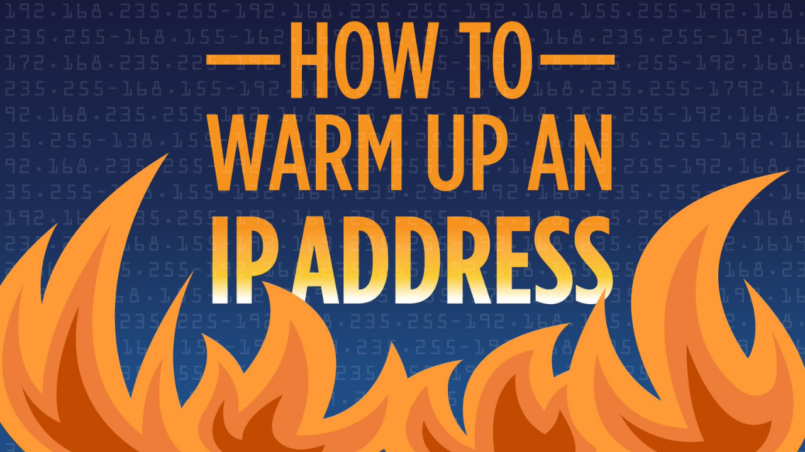IP warming is a crucial process for ensuring optimal email deliverability and minimizing the risk of your emails being marked as spam or being rejected by mailbox providers. It involves gradually increasing the volume of emails sent from a new IP address to establish a positive sending reputation.
What is IP Warming
When you start sending emails from a new IP address, mailbox providers are unable to determine whether you are a legitimate sender or a spammer. By gradually increasing the volume of emails sent from the new IP address, you can prove to mailbox providers that you are a trustworthy sender. This process of building a positive sending reputation is known as IP warming.
Why IP Warming is Important
IP warming is essential for the following reasons:
- Improved Email Deliverability: A positive sending reputation ensures that your emails are more likely to reach the recipient’s inbox rather than being marked as spam or rejected.
- Enhanced Domain Reputation: A warmed-up IP address contributes to a better domain reputation, which further improves email deliverability.
- Avoiding Blacklisting: Sudden spikes in email volume from a new IP address can lead to blacklisting by mailbox providers. IP warming helps to avoid this issue.
IP Warming Schedule
An effective IP warming schedule involves gradually increasing the volume of emails sent from the new IP address over time. The ideal schedule depends on factors such as your target audience, the type of emails you send, and your desired sending volume. Here’s a sample IP warming schedule:
| Day | Email Volume |
|---|---|
| 1 | 50 |
| 2 | 100 |
| 3 | 200 |
| 4 | 400 |
| 5 | 800 |
| 6 | 1,600 |
| 7 | 3,200 |
Adjust the schedule as needed based on your specific requirements and monitor your email deliverability metrics to ensure success.
IP Warming Strategy
To maximize the effectiveness of your IP warming efforts, follow these best practices:
- Start with Engaged Recipients: Initially, send emails to recipients who have recently engaged with your content, such as opening or clicking on emails. This will help establish a positive sending reputation more quickly.
- Segment Your Email Lists: Divide your email list into segments based on factors such as engagement levels, demographics, or interests. This will allow you to personalize your emails and increase engagement rates.
- Monitor Deliverability Metrics: Keep a close eye on key deliverability metrics, such as open rates, click-through rates, bounce rates, and spam complaint rates. These metrics will help you gauge the effectiveness of your IP warming strategy and make adjustments as needed.
- Maintain Email Sending Best Practices: Ensure that you are following email sending best practices, such as using double opt-in for list building, maintaining accurate sender information, and keeping your email content relevant and valuable to recipients.
Pitfalls to Avoid During IP Warming
To ensure a successful IP warming process, it’s essential to avoid certain pitfalls that could negatively impact your sending reputation and deliverability:
- Sending Too Many Emails Too Soon: Rapidly increasing email volume can lead to a negative sender reputation, as mailbox providers may perceive you as a spammer. Stick to your IP warming schedule and gradually increase email volume over time.
- Poor Email List Quality: Sending emails to outdated or low-quality email lists can result in high bounce rates and spam complaints, damaging your sender reputation. Regularly clean your email list, removing inactive subscribers and incorrect email addresses.
- Inconsistent Sending Volume: Maintaining a consistent sending volume is crucial for IP warming. Sudden fluctuations in email volume can raise suspicion among mailbox providers. Ensure that you follow your IP warming schedule and maintain a consistent sending volume.
- Ignoring Engagement Metrics: Failing to monitor and respond to changes in engagement metrics can hinder your IP warming efforts. Keep a close eye on key metrics and adjust your strategy as needed to maintain a positive sender reputation.
Tools to Assist in IP Warming
There are several tools available to help you monitor your IP warming progress and maintain a positive sender reputation:
Email Deliverability Testing Tools: Services like MXToolbox, Mail-Tester, and SMTPer can provide insights into your email deliverability, helping you identify and resolve issues that could impact your IP warming efforts.
Email Verification Tools: Tools such as Debounce, EmailistValidation, and Clean Email can help you clean and maintain a high-quality email list by verifying email addresses and removing invalid or inactive contacts.
Email Analytics Platforms: Platforms like GetResponse, SendInBlue, and Mailracle offer built-in analytics that can help you monitor engagement metrics and optimize your email campaigns during the IP warming process.
Conclusion
IP warming is a critical process for ensuring optimal email deliverability and minimizing the risk of your emails being marked as spam or rejected by mailbox providers. By following a well-planned schedule, employing a thoughtful strategy, avoiding common pitfalls, and leveraging available tools, you can successfully warm up your IP address and establish a positive sender reputation. In turn, this will improve your email deliverability, enhance your domain reputation, and ultimately contribute to the success of your email marketing efforts.







